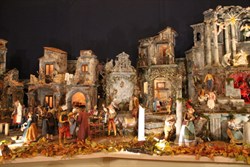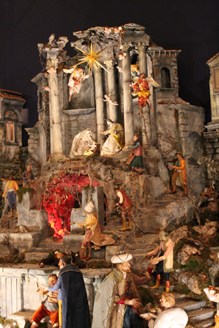Charles III of Spain and his passion for the Neapolitan Nativity scene
 Although examples of the Neapolitan Nativity scene (belén in Spanish) in Spain are already documented since at least the fifteenth century, it was in the eighteenth century when the taste and passion for this expression of Neapolitan culture spread. In 1759, when Charles III came to Madrid from Naples, the new King of Spain brought some specimens of the Nativity scene that he had acquired during his reign in Naples (1734-1759) with him. In accordance to the wish of the monarch, they were mounted in various Sitios RealesAre the places, especially palaces, that have served as the residence of the Spanish monarchs. Because of their historical and cultural importance El Escorial, the Palace of Aranjuez and the Royal Palace of Madrid stand out in particular. Inside they have preserved an important artistic heritage which consists in the original furniture that belonged to the royal family and of collections of paintings and tapestries of great value. Noteworthy are also gardens, fountains and lakes that surround these palaces. (Royal residences) with figures brought from Italian territory. These Nativity scenes were far removed from the normal religious symbolism and could be construed rather as a reflection of the world of the court, in the figures used and ostentation. The luxury of buying unique pieces from Naples brought the Spanish aristocracy to imitate the royal family by putting together collections of figurines for Nativity scenes to show off in their own homes every Christmas. In addition, each year the high nobility of the kingdom went to the Palace to admire the Belén del Príncipe (image 1), which steadily increased in size with the annual purchase of new pieces and that was accessible to the upper echelons until the twentieth century, through an appointment with the Mayordomo Mayor de Palacio (the Chief Majordomo of the palace). Thus began an intense traffic of Nativity scene figures between Spain and the Kingdom of Naples, and in particular Charles III’s court of Madrid constantly requested new pieces for his children’s Nativity scenes. The Belén del Príncipe, that is to say, that of the future Charles IV, was the one that needed more care, because of its high number of pieces, with the elegant fabrics used in it and the technique and finishing which were always perfect. Charles IV inherited the passion for the Christmas tradition from his father, and continued to enlarge and to exhibit the Neapolitan Nativity scene every year in the Royal Palace.
Although examples of the Neapolitan Nativity scene (belén in Spanish) in Spain are already documented since at least the fifteenth century, it was in the eighteenth century when the taste and passion for this expression of Neapolitan culture spread. In 1759, when Charles III came to Madrid from Naples, the new King of Spain brought some specimens of the Nativity scene that he had acquired during his reign in Naples (1734-1759) with him. In accordance to the wish of the monarch, they were mounted in various Sitios RealesAre the places, especially palaces, that have served as the residence of the Spanish monarchs. Because of their historical and cultural importance El Escorial, the Palace of Aranjuez and the Royal Palace of Madrid stand out in particular. Inside they have preserved an important artistic heritage which consists in the original furniture that belonged to the royal family and of collections of paintings and tapestries of great value. Noteworthy are also gardens, fountains and lakes that surround these palaces. (Royal residences) with figures brought from Italian territory. These Nativity scenes were far removed from the normal religious symbolism and could be construed rather as a reflection of the world of the court, in the figures used and ostentation. The luxury of buying unique pieces from Naples brought the Spanish aristocracy to imitate the royal family by putting together collections of figurines for Nativity scenes to show off in their own homes every Christmas. In addition, each year the high nobility of the kingdom went to the Palace to admire the Belén del Príncipe (image 1), which steadily increased in size with the annual purchase of new pieces and that was accessible to the upper echelons until the twentieth century, through an appointment with the Mayordomo Mayor de Palacio (the Chief Majordomo of the palace). Thus began an intense traffic of Nativity scene figures between Spain and the Kingdom of Naples, and in particular Charles III’s court of Madrid constantly requested new pieces for his children’s Nativity scenes. The Belén del Príncipe, that is to say, that of the future Charles IV, was the one that needed more care, because of its high number of pieces, with the elegant fabrics used in it and the technique and finishing which were always perfect. Charles IV inherited the passion for the Christmas tradition from his father, and continued to enlarge and to exhibit the Neapolitan Nativity scene every year in the Royal Palace.
 Even today, every Christmas, the public can admire the Belén del Príncipe, which preserves some of the figures of the time of Charles III, such as the Magi (image 2), while others, like the shepherds, innkeepers or traders, have disappeared or have lost their original clothes. Nevertheless, the missing figures have been replaced by others, always Neapolitan, and the Belén has maintained prestige and importance. In its early heyday, it had come to have a total of 5,950 pieces, acquired between 1786 and 1788 and was made by some of the most important Neapolitan artists and Giuseppe SammartinoGiuseppe Sammartino (1720-1793) was an important Italian sculptor, a leading figure in the art scene of eighteenth century Naples. His most famous work is undoubtedly the marble Veiled Christ made for the chapel of the Princes of Sangro di San Severo in Naples, the Cappella San Severo. But in his long career Sammartino was the author of other great works, such as the decoration of the altar of the Church of the Nunziatella (Annunciation). He was also a creator of Nativity scenes. was undoubtedly responsible for the most important figures. For their part, Matteo BottiglieroMatteo Bottigliero or Bottiglieri (1684-1757) was an important eighteenth-century Neapolitan artist, sculptor and painter. Like other artists of his generation, he became known for his rich production of Nativity scenes. used porcelain for the heads of some of the statues, while Giuseppe Gori was responsible for most of the parts of the animals.
Even today, every Christmas, the public can admire the Belén del Príncipe, which preserves some of the figures of the time of Charles III, such as the Magi (image 2), while others, like the shepherds, innkeepers or traders, have disappeared or have lost their original clothes. Nevertheless, the missing figures have been replaced by others, always Neapolitan, and the Belén has maintained prestige and importance. In its early heyday, it had come to have a total of 5,950 pieces, acquired between 1786 and 1788 and was made by some of the most important Neapolitan artists and Giuseppe SammartinoGiuseppe Sammartino (1720-1793) was an important Italian sculptor, a leading figure in the art scene of eighteenth century Naples. His most famous work is undoubtedly the marble Veiled Christ made for the chapel of the Princes of Sangro di San Severo in Naples, the Cappella San Severo. But in his long career Sammartino was the author of other great works, such as the decoration of the altar of the Church of the Nunziatella (Annunciation). He was also a creator of Nativity scenes. was undoubtedly responsible for the most important figures. For their part, Matteo BottiglieroMatteo Bottigliero or Bottiglieri (1684-1757) was an important eighteenth-century Neapolitan artist, sculptor and painter. Like other artists of his generation, he became known for his rich production of Nativity scenes. used porcelain for the heads of some of the statues, while Giuseppe Gori was responsible for most of the parts of the animals.
The heads and arms of the characters in the Belén del Príncipe were in porcelain, while the rest of the body was made of jointed wood. Paintings and gold and silver embroidery were used for the clothes, with small jewels. The animals were instead made of lead. The scenery changed every year with a new and ephemeral assembly, but there were still scenes that were never replaced (the inn, tavern and market), while new ones were added each year. This operation is put into practice today: for Christmas of 2013, at one end of the Belén del Príncipe a camp with tents and Ottoman soldiers had been added, while at the other end, one could see the arrival of a king or a ambassador aboard a gilded carriage.
